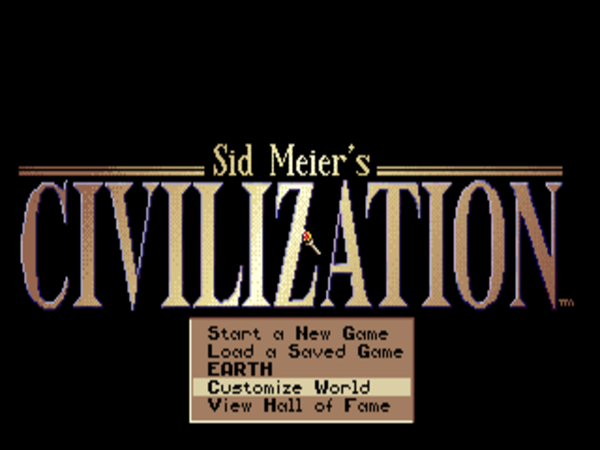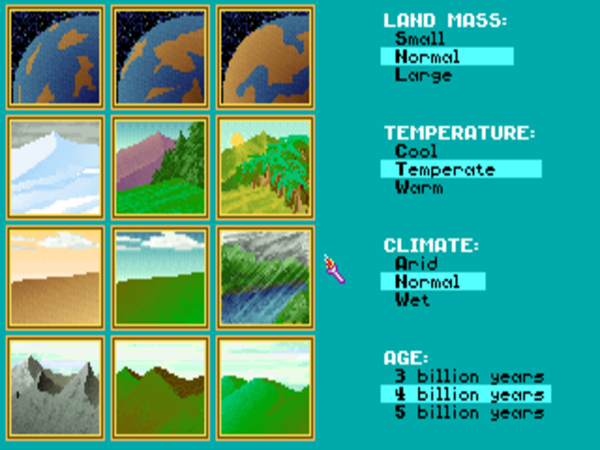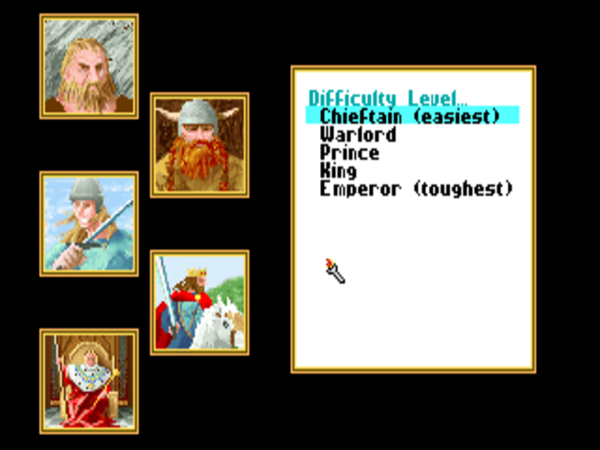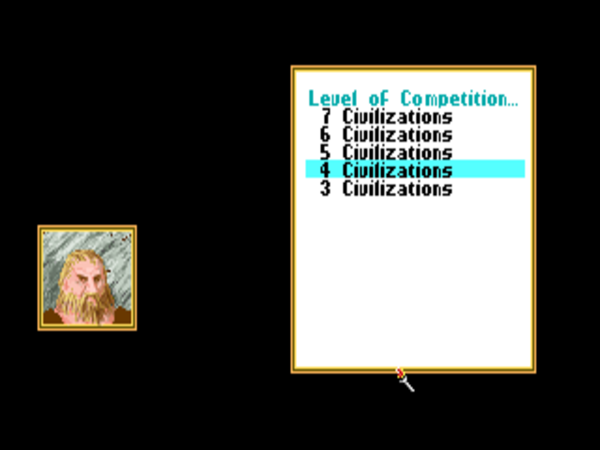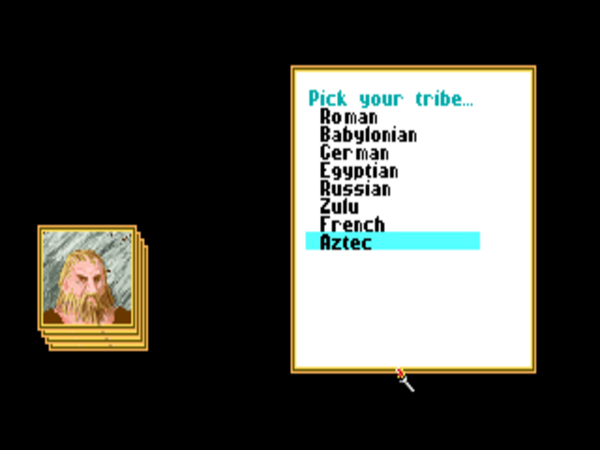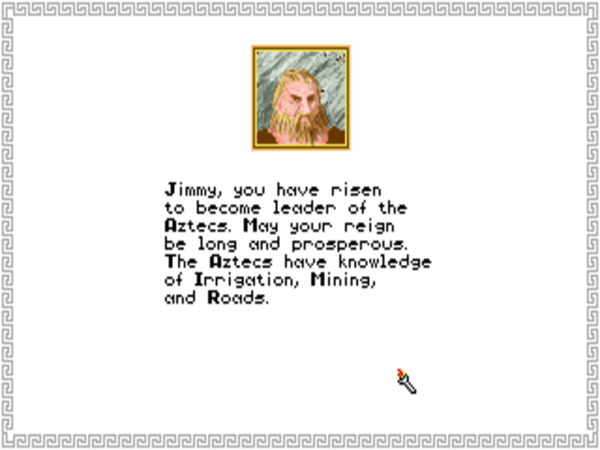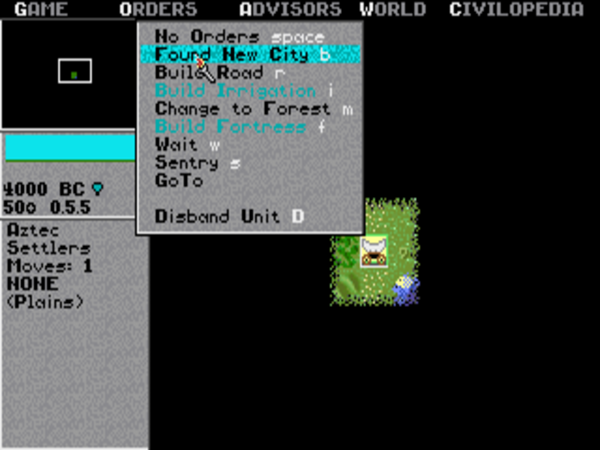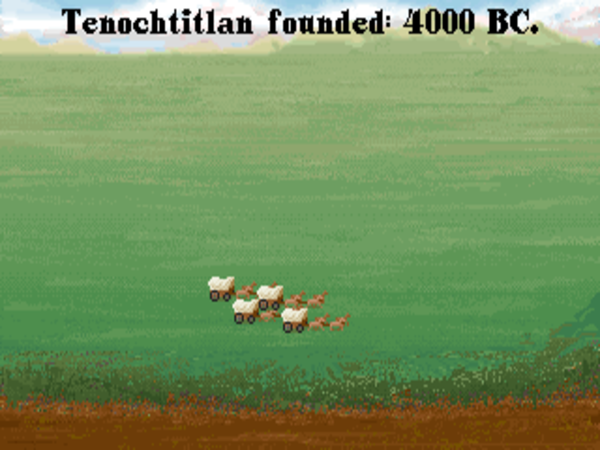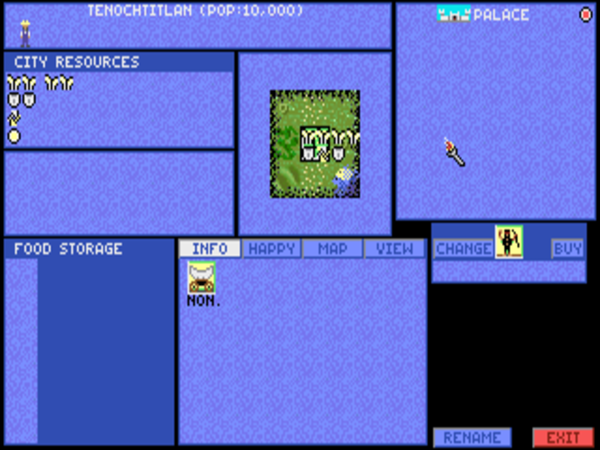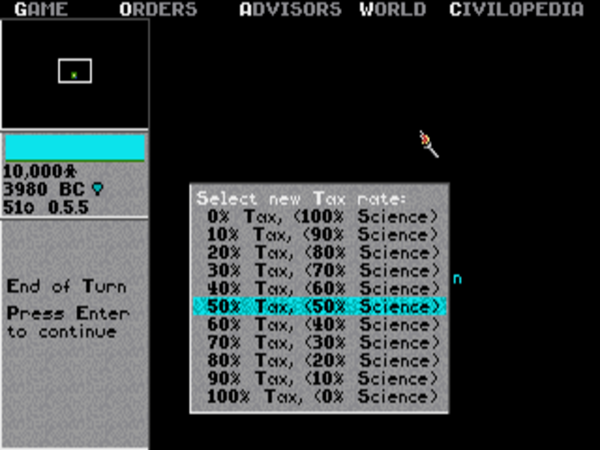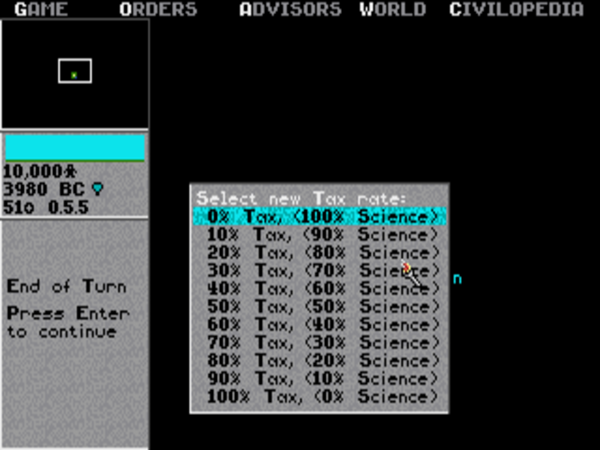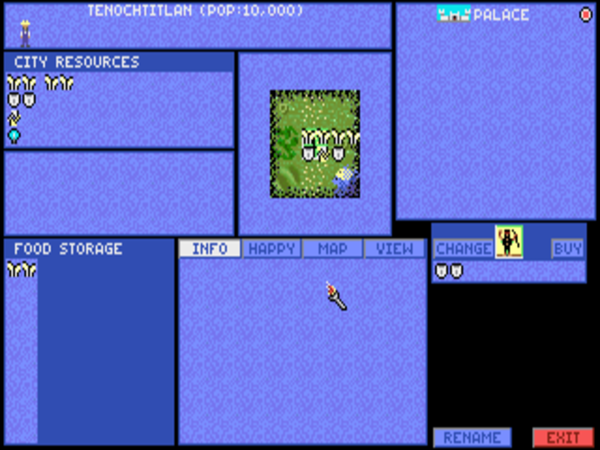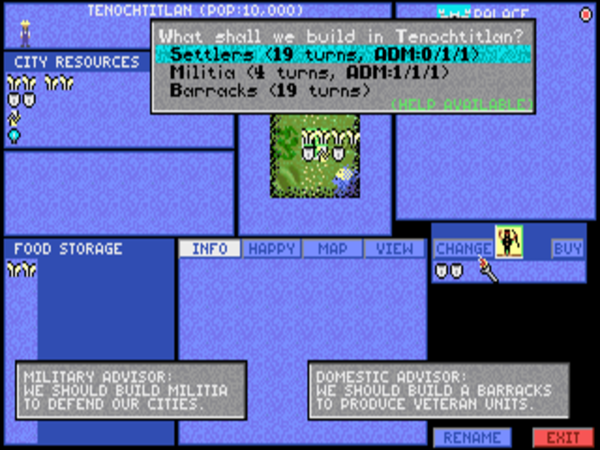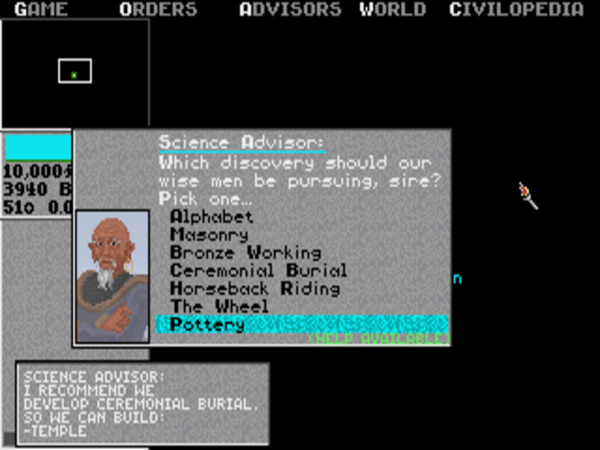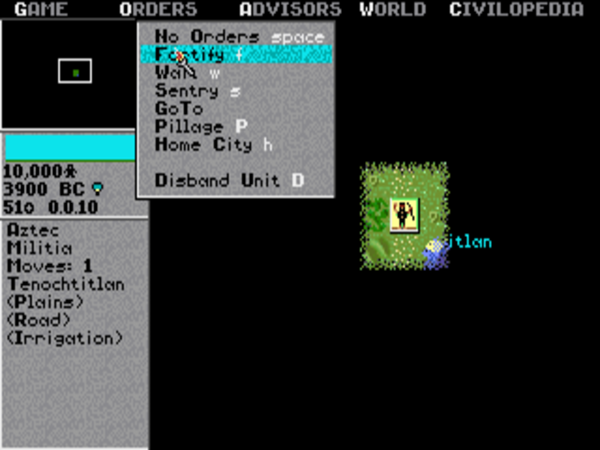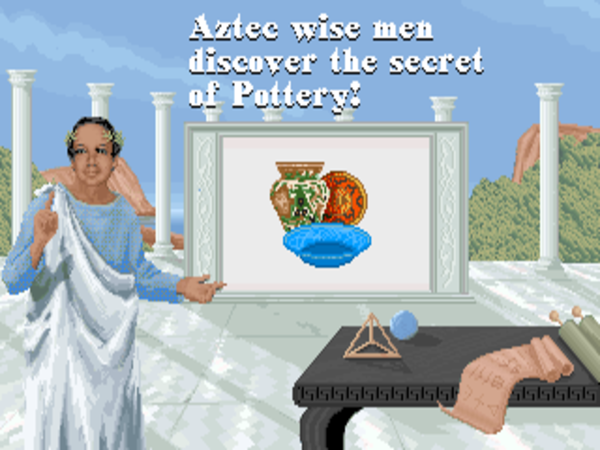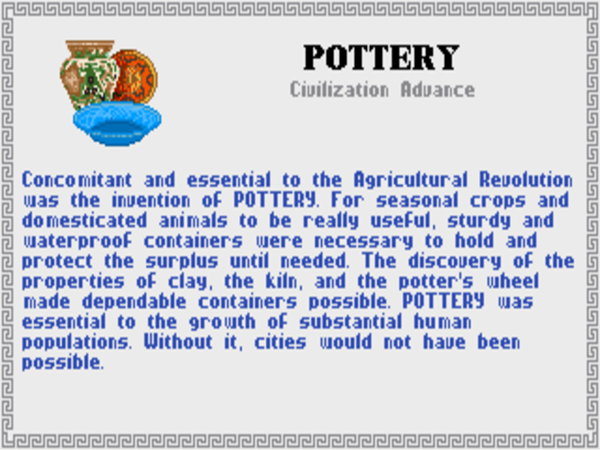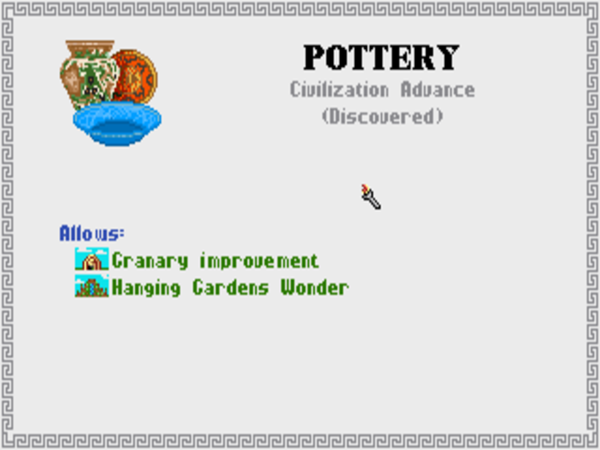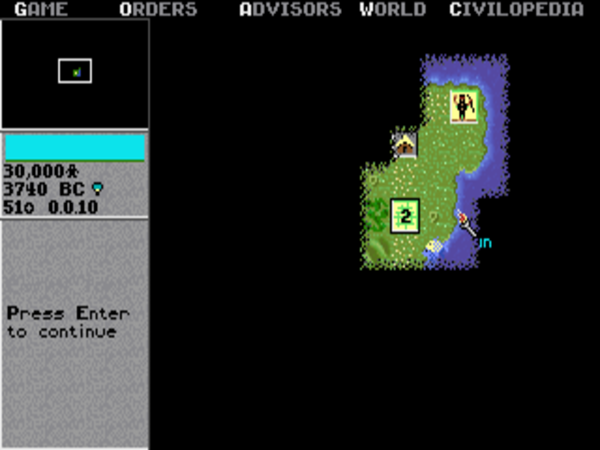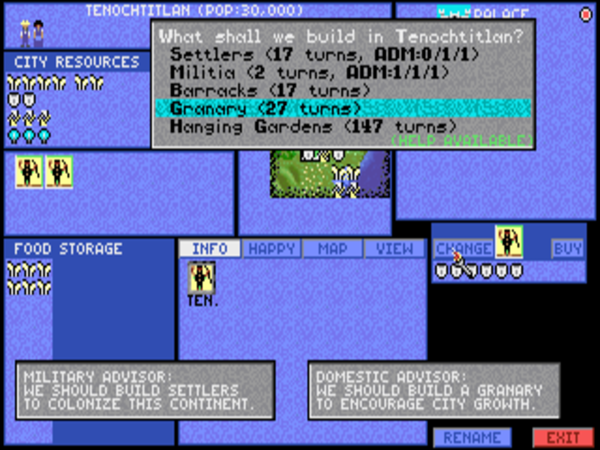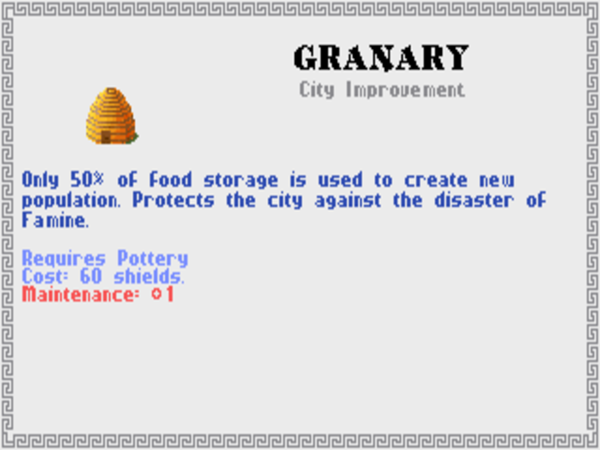As a game designer, you have ultimate power. And with this ultimate power comes very little responsibility.
— Sid Meier
I don’t intend for this series of articles to be a tutorial on the game of Civilization, much less a strategy guide. You can find heaps of that sort of thing elsewhere, written by players much more skilled than I’ll ever be.
That said, it would be helpful for the articles I do want to write if those of you who haven’t played the game before, or who haven’t played it in a long time, could have a basic understanding of how its systems fit together. So, let’s start today with a brief guided tour of a typical game’s beginning phases.
The first choice we have to make is whether to play on our own planet Earth or on a randomly generated world. As any Civilization veteran will tell you, this is really no choice at all. Playing on Earth robs the game of the magic of discovery that Sid Meier had found so appealing in Empire, one of Civilization‘s biggest inspirations. When you play on Earth, not only are you playing on a world whose geography you already know, but the various civilizations, including your own, will always start in their historic locations. So, a random world it is.
Having chosen a random world, we can change four parameters that will affect its personality. For this introduction, we just take the default, middle-of-the-road settings.
While our new world is being generated by the computer in the background, we see a little movie showing how our nascent civilization came to be through the forces of geology and biology. Neither the writing nor the graphics are perhaps all they might have been, but it nevertheless gets across the right note of auspicious grandeur.
Now we need to choose our difficulty level. This choice doesn’t so much affect the artificial intelligence’s ability to reason, which is at best limited under any circumstances, so much as it does the amount of cheating the computer does on behalf of one side or the other. The official line has it that the penultimate “King” level offers an equal balance of power, with levels below that giving the advantage to the human player and the ultimate “Emperor” level giving a decided advantage to the computer-run civilizations. In the real world, King is widely considered to provide a very stiff challenge indeed, and Emperor is sometimes simply unwinnable even for the very best players. We’ll take the cakewalk level of “Chieftain” today, if for no other reason than to ensure that we don’t get ourselves wiped out somehow before we’ve gotten through this whole introduction.
Next we choose how many civilizations, including ours, will occupy the planet. We’ll go with a relatively sparsely populated world of just four civilizations because this introduction would prefer to focus on the core mechanisms of the game rather than on diplomacy and other interactions with our rivals.
Now we get to choose which culture — i.e., which civilization — we wish to play as. There are fourteen possible civilizations in the game, but we only get to choose from all of them if we include the maximum of seven active civilizations in our world. Why? I don’t really know; it must have seemed a good idea at the time to Sid Meier and Bruce Shelley. At any rate, the choice is cosmetic only; all cultures are the same from the standpoint of play. Just for the heck of it, we’ll take the Aztecs.
After we’ve chosen, the computer will fill out the rest of the world’s roster of four civilizations with random picks. The computer-controlled civilizations are lent a degree of historical verisimilitude by the fact that their leaders are given different priorities and personalities. The leaders chosen for the various cultures span the ages, from Hammurabi on the part of the Babylonians to Chairman Mao on that of the Chinese.
And so we begin…
We start with a single “settlers” unit. Throughout the game, these will be our workhorse units. Although they have no offensive or defensive capabilities to speak of, they are essential for developing a civilization’s infrastructure: irrigating land, building roads, digging mines, eventually laying down railroads to connect our cities. Their most important capability of all, however, is also the source of their name: one can be ordered to found a new city, whereupon the settler unit disappears and a nascent settlement appears in its place. We could move around a bit to try to find a better spot for our first city, but right where we are, surrounded mostly by fertile grassland and with access to the ocean for when we become a seafaring nation later on, isn’t a bad location. So, on our very first turn, we found our very first city of Tenochtitlan — the name is chosen by the game, although we can change it if we wish to — right here where our very first settler started.
With Tenochtitlan thus established, it’s up to us to direct its development via the city-management screen. This screen is, one might say, the heart of the original game of Civilization, the “country simulator” Sid Meier conceived in 1989, before the military game or the Advances Chart existed. It conveys a lot of information, with much of which we need to have at least a passing familiarity even for the purposes of this brief introduction.
Note the little man at top left, just under the name of the city and its numerical population. Because there’s just one of him, we know that Tenochtitlan is a size 1 city, the smallest possible. More of him will appear as the city grows, but he’s important as more than just a visual depiction of population; he also reflects the city’s morale. At the moment, his neutral-looking appearance tells us that he’s “content,” neither disgruntled nor joyously happy. Managing a city’s morale is beyond the scope of this introduction, but know that it will become a critical area of focus as time goes on and our cities really start to grow. Luckily, we’re playing at the Chieftain level, which means it will be quite some time before morale becomes a pressing concern; the first unhappy citizens won’t start appearing until there are six of those little men lined up in a row for any given city.
Below the little man we have the “City Resources” box. Resources are claimed from the land that surrounds a city, as is illustrated on the map view near the center of the screen. Different types of terrain can produce different types and quantities of resources. We always get the resources located in a city’s central square. In addition, we can “work” one square of land per unit of population size — i.e., per little man — to receive the resources from it as well. The computer initially chooses for us where our workers are placed, but we can always change its choices by clicking on the map view. For now, though, let’s look at the meanings behind the resource icons themselves.
Food production is represented as stalks of wheat, of which each unit of population needs two per turn to avoid famine. Thankfully, our new city is producing four per turn, meaning that we’re generating two extra food per turn beyond our population’s current needs; thus the gap between the two pairs of icons. We’ll return to this extra food in a moment.
Industrial production is represented by the little shields. (“Why shields?” Sid Meier has been asked. “Because they showed up clearly as an 8 X 8 matrix of pixels,” he answered.) They reflect the speed at which the city can build things. We’ll return to them as well in a moment.
The final two icons are a more complicated, interlinked pair. The icon on the third line doesn’t have any obvious name; “trade arrows,” the Civilization community’s standard name for it, will do as well as anything. It represents our city’s combined economic and intellectual potential. The icon on the fourth line represents money; our city is currently generating one “coin” per turn, thanks to its one trade arrow.
But trade arrows need not be used only to generate money. They can also generate what the Civilization community typically calls “science” — meaning intellectual development or research, as represented by little light-bulb icons. In one of those clever little relations with which the game abounds, our science rate is always the inverse of our tax rate. When we began the game, our civilization’s tax rate was set to 50 percent by default, meaning that 50 percent of our trade arrows are converted into coins, the other 50 percent into light bulbs. But because our new city is only producing one trade arrow, and trade arrows cannot be split, the game had given all of our meager trade income to taxes; thus the coin icon below the trade arrow.
We can turn our single coin into a single light bulb by changing our civilization’s tax rate from 50 percent to 0 percent.
Let’s return to the city-management screen now. Notice that the single coin in the fourth row of the City Resources box has indeed been replaced by a single light-bulb icon.
But, you might be asking, what are the coins and light bulbs actually good for anyway? Well, coins are used to pay the upkeep on our cities and military units, and can also be used to rush production jobs faster than a city’s industrial potential would normally allow. And later, when we begin to meet other civilizations, they can be used to pay tributes to them. Light bulbs, on the other hand, are funneled into the research projects that let our civilization climb the Advances Chart and develop new capabilities.
At the Chieftain level the game is kind enough to grant us a starting reserve of 50 coins, and at this early stage of our civilization’s development we have no upkeep costs yet. It’s for this reason that we can safely funnel all of our trade into research right now. Later on, of course, this will no longer be the case.
Now let’s look at the rest of the city-management screen. Remember that extra food from the City Resources box, above and beyond what our city needed to surive? That accumulates turn by turn in the “Food Storage box” to the bottom left. Because Tenochtitlan is a size 1 city, only the first two columns of this box need to be filled right now; a size 2 city will have three active columns, and so on. When the food icons spill past the bottom of the box, our city grows by one, giving us one more little man we need to feed at the cost of two food per turn, but that same little man can in turn be used to work another square, harvesting more resources. The same process is repeated to grow from size 2 to size 3, and so on. Because one more column becomes active in the Food Storage box each time we grow, we need proportionally more food to grow a city to each new stage. Eventually most cities will reach an equilibrium point where they’re using all of their food production just to maintain their existing population. Exactly where that point is depends on the terrain surrounding the city, our efforts to develop said terrain, our type of government, and our technological development.
We’ll skip the empty box at the bottom center of the screen, which can display information on local military units and other things we’d rather not dwell on now. Instead look to the top right. Here we see a list of the all of the major buildings in our city. At the moment, the list consists only of our ruling palace, which we get as a freebie with our first city. Until we do some research, we don’t even have the ability to build much else.
Finally, at bottom right, we see what the city is currently using its industrial potential — those little shield icons — to produce, as well as how far along we are with the current project. We can build, as shown by the menu displayed above, either mobile units or immobile buildings. Note that, because we’re playing at Chieftain level and thus are presumably new to the game, we get some “advisors” offering suggestions of what to do next. Such a level of consideration for the beginning player was still quite unusual in Civilization‘s day, especially in a relatively hardcore strategy game like this one.
Just as with city growth, we need to fill up the shaded area with icons to finish a project. We’re currently building a militia unit, the most basic military unit in the game, which every civilization starts with the ability to make. It’s also the cheapest unit, costing just ten shield icons. Because our city produces two shield icons per turn, it will take a total of five turns, each spanning twenty years — i.e., an entire century in all — to make our first militia. Civilizations in the game, like civilizations in reality, take a while to really get going.
But as we’re waiting on our first militia, the cultural progress which might eventually lead us all the way to Alpha Centauri begins when we’re asked which advance we’d like to research first. With all due respect to our science advisor, we’ll go with Pottery.
Because our research capabilities are so meager, it will take quite a few turns to acquire our first advance. So, we’re back to waiting.
Right on schedule, in 3900 BC, our first militia unit is completed at last. Although we’re itching to use it to explore all that terra incognita around us, we should try to resist the urge. If another civilization or one of the barbarian clans that roam the world should stumble across our single undefended city, that would mark the end of our game right there. Instead we should fortify our militia in the city — fortifying it increases its defensive capabilities by 50 percent — and keep waiting while our city builds a second militia.
In the meantime, we finally discover Pottery. (Yes, that is Sid Meier dressed up as a Roman noble.)
The game helpfully tells us a little bit about the advance — not only about its importance in gameplay terms, but also about its importance in the real history of human civilization.
While our “wise men” are researching our next advance — we’ve chosen Alphabet this time — our second militia unit has been completed, and we use it to begin pushing back the edges of the known world. Notice as well that our city has grown to size 2.
Indeed, the city-management screen for Tenochtitlan shows that everything is going quite well there. We’re still producing plenty of extra food, meaning we can expect to grow to size 3 before too many more centuries have passed, despite the fact that doing so requires a greater absolute quantity of food than did growing from size 1 to size 2. Thanks to our second worker, we’re now generating three trade arrows per turn instead of one, meaning we can expect our research to go three times faster. And the fact that we’ve finished researching Pottery means that we’re now able to start building a granary.
Granaries, like all buildings, provide a benefit to the cities that house them, as is explained by the game’s online help, or “Civilopedia” — itself a very innovative feature in its day. By causing the cities that house them to only empty their Food Storage boxes of half their food when they grow, granaries can in a best-case scenario double the pace of a city’s growth. Note as well, however, that they come with a maintenance cost, meaning our citizens’ blissful tax-free existence must soon come to an end.
We’re still in the very earliest stages of building our civilization, but the completion of our first building nevertheless seems like a good place to wrap up this introduction. In the centuries and millennia to come, we’ll explore the entirety of our starting continent and perhaps, once we get the ships to do so, of our world. We’ll build many new settler units to found many more cities. We may switch from our starting government of Despotism, which is well-suited to a civilization pulling itself up by its bootstraps but not terribly conducive to long-term development, to Monarchy; still later, our civilization might become a republic, a democracy, or even a communist state. We’ll irrigate the fields outside our cities to improve their food yields, build mines in the hills around them to increase their industrial potential, and bind them all together with a network of roads and, eventually, railroads. We’ll build Wonders of the World, both for the concrete benefits they provide and for the bragging rights of having done so. And at some point — possibly as early as next turn, possibly not for many centuries yet — we’ll meet other civilizations. When that happens, we’ll have to decide whether to try to coexist with them peacefully, setting up diplomatic relations and trade routes, or whether to go to war — or perhaps they will force war upon us. Through it all, we’ll keep marching up the Advances Chart, until, just maybe, the fine day will come when we send a spaceship to Alpha Centauri to inaugurate humanity’s next grand adventure.
Each new civilization we make will be shaped to some extent by the pressure of events around it, but much of its personality will always come down to what we feel like trying in that particular game. Free-trading democracy keeping the peace with a strong military it hopes never to use; aggressively expansionist empire that uses its strong military well and often; humble nation concentrating on culture and paying other civilizations tribute to keep them from invading; wily communist state keeping the world off-balance through sabotage and spycraft. All are possibilities worthy of experimentation in the laboratory of Civilization.
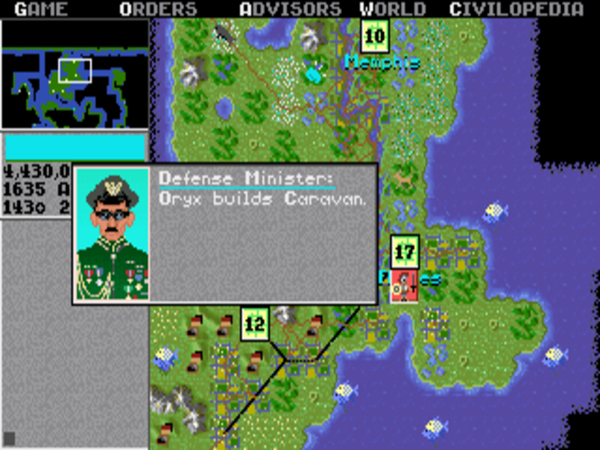
A well-developed civilization of AD 1635, in the process of connecting its enormous cities together via railroad.
The core genius of Civilization as a piece of game design is the way that it manages to subsume all of this universe of possibilities, along with every era of technology and culture from 4000 BC to the near future, within the same set of simple rules and processes. Civilization itself isn’t a particularly simple game; there’s always much to think about as you juggle your country’s economy, its military, and its long-term progress. Yet the core mechanisms which foster it all really are disarmingly simple, and change little if at all over the course of 6000 years of history. The game accomplishes this feat by teasing out the core similarities amid all the differences. In terms of transportation infrastructure, railroads are just faster roads; in terms of the military, an armor unit is just a much more potent militia; in terms of progress, each advance is researched in exactly the same way, whether it be the alphabet or atomic physics.
Mechanisms and even interface elements are reused whenever possible. A rather shocking percentage of the game is built around a conceit we’ve already seen plenty of, one that Sid Meier summarizes as “filling up little boxes.” When the Food Storage box is full, a city grows; when a production track is full, a building or unit gets built; when a little light bulb on the main display is full of color, whatever advance is currently being researched gets finished. The thoroughgoing commitment to simple and consistent mechanisms means that a Space Age civilization, although it might have a hundred or a thousand times more population and potential than one just coming out of the Stone Age, is nevertheless controlled exactly the same. Rather than alter the core mechanisms of the game, new developments change only the numbers, or confer some advantage that makes the numbers climb more efficiently; think again of the granary improvement that means that only half instead of all of your stored food disappears when your city grows. Thus when you acquire new capabilities it feels exciting rather than daunting because you already have an intuitive feel for how they work. Civilization does have a learning curve, but it’s one that can be conquered in your first few hours with the game. If you know how to use your settlers to irrigate a field in 2000 BC, you know how to use them to clean up industrial waste in AD 2000. [1]The one glaring exception to this rule is the implementation of the game’s potential capstone, the trip to Alpha Centauri. An entirely new element of spaceship design and construction suddenly enters at this point. Introducing such a thing in the endgame of a strategy game that could consume ten or twenty hours to play through is rather jarring. It strikes me as a rare example of Sid Meier, usually a judicious editor of his own designs, letting in one idea too many.
Civilization‘s ability to hook its player has achieved legendary status; it was with the appearance of this game that the just-one-more-turn syndrome became an in-joke of gamers everywhere. “There’s a compulsion about it that transcends fun,” notes Sid Meier. He shares an anecdote:
In the middle of development, we went on a vacation, and my brother started playing an early prototype of the game. He was in his teens at the time. We didn’t see him for hours. That was an indication that there was something compelling [here] that we hadn’t tapped into before. We had a sense that there was something a little different about this game.
For all their skill as designers, neither Meier nor Bruce Shelley entirely understood at the time Civilization shipped just how they had managed to create a game that would soon be described as more addictive than crack cocaine. Looking back on it today, Meier believes that the happy (?) accident resulted from the way that Civilization keeps you constantly looking forward to the future — to finishing your research into airplanes, to getting that Copernicus’s Observatory Wonder finally finished, to finally taking out those pesky Mongols — combined with the way that the game’s many overlapping elements make it resistant to the idea of chapter breaks in the unfolding story of your civilization. Big expectations for the immediate future and a lack of obvious stopping places make for a potent combination indeed, one that has led to countless bleary-eyed workdays, to meals untasted, to responsibilities neglected. Once Civilization sucks you into its world, it can be incredibly difficult to climb back out again.
Which isn’t to say that Civilization‘s world is entirely without its discontents. The game does have two significant problems, which I’ll call the devil in the details and the long anticlimax.
The devil in the details arises out of the very goal of most Civilization players: to grow their civilization as much as possible. What’s pleasant and simple at the beginning of the game, when you have just one city to deal with, can become a monumental headache by the middle phases, when you might have a dozen or more cities and, especially if you’re the aggressive type, a hundred or more military units to manage. How do you keep everything straight in such a situation, and how do you keep all the micromanagement from becoming deathly boring? The deeper you play into Civilization, the more time-consuming each turn becomes. Much — most, really — of what you do with all those cities and units is obvious and rote. Each city you found will go through a fairly consistent series of stages in its development: first you’ll want to see to its defense, then you’ll want to construct a granary to speed up its growth, etc. Similarly, units which you’ve decided should be used to accomplish any given strategic or tactical goal generally carry out the details of their work in a fairly rote way. Once you’ve decided to earmark a settler to improve the land around a city, for example, the process of moving it from square to square and issuing commands to irrigate and to build roads becomes a largely mindless one. In addition to the sheer tedium of all this micromanagement, the player who’s trying to think strategically can all too easily begin to miss the forest for all these trees. An extremely small percentage of the orders you issue in any given turn might require real, careful thought, and it’s hard to separate those orders out from all the busywork. It’s hard to feel like Napoleon when you also have to play the role of a low-level bureaucrat in his public-works department.
The long anticlimax, on the other hand, begins after you’ve built your civilization up to a reasonable maturity, have grown more powerful than your biggest rivals — or more powerful than all of them put together — and thus pretty much know that you’re going to win. Sid Meier has famously described a good game as “a series of interesting decisions,” a description which certainly applies to Civilization in the broad strokes. But when you enter the long anticlimax, the interesting decisions are all behind you, yet the game still has a long, long way to go. You’ve reached the point where, if this was a movie, the credits would start to roll. And yet, especially if you’re playing for Alpha Centauri, you could still be facing centuries or millennia of the sort of rote management functions I just described in the previous paragraph. Even if you’re playing to conquer the world, you’re facing a series of wars you know you’re going to win, possibly capped by the supreme anticlimax of scouring the ends of the earth for some final pissant rival marooned on an island somewhere in the middle of nowhere.
These two problems hardly came to Civilization out of the blue. Decades of board-game designs, and a fair number of earlier computer strategy games as well, had struggled with them by the time Meier and Shelley embarked on their game of everything. The pair was sufficiently aware of the devil in the details to take some steps to head him off. They added an option to switch cities into an automated building mode, where the computer chooses whatever building seems appropriate to it to build next. They also made it possible to issue longer-term orders to units, telling them to “go to” a given map square instead of guiding them manually to their destination turn by turn. But, limited as the two designers doubtless were by the technology with which they worked, neither solution turned out to be ideal. The computer’s choices for city development are often inexplicable, and even more often incompatible with whatever specific strategy you happen to be pursuing, while the game’s path-finding is so bad that ordering a unit to “go to” a destination more than half a dozen squares away tends to result in it getting confused, and finally just giving up on some random square that may or may not be closer to the destination than the one it started from.
When I wrote about Railroad Tycoon, Meier and Shelley’s previous strategy game, I described it as a tighter, more elegant design than Civilization in purely structural terms, and I hold to that opinion still. The older game’s limits on the numbers of trains and tracks the player can build keep the combinatorial explosion at bay, and because every game of Railroad Tycoon is limited to exactly 100 years it generally ends while competition is still raging.
Of course, any game is ultimately a partnership between its designer and its player. In the case of Civilization, there are things the player can do to mitigate its two greatest failings. Once the limitations of the path-finding are understood, “go to” orders can become a useful convenience, if not as useful as they might have been, as long as units’ destinations are confined to reasonably straightforward routes covering limited distances. And then, it’s perfectly possible to build a thriving little capitalist democracy of only five or six cities that’s capable of winning the race to Alpha Centauri — thus avoiding much of the tedious micromanagement that goes into more sprawling empires. For that matter, one could even imagine a player setting her own conditions for declaring victory early, thus avoiding the long anticlimax.
At any rate, I certainly don’t want to hammer Civilization too badly on these fronts. These issues really are some of the most intractable in strategy-game design — perhaps some of the most intractable in game design, period — and Meier and Shelley were far from the first to struggle with them in the digital or analog space. In the years since the original Civilization, a multitude of weapons have been brought to bear against them, from artificially-intelligent lieutenants who can be given a broad strategic direction to follow to scenario-based game-ending goals that are more specific than the likes of “conquer the world or fly to Alpha Centauri.” And yet, even with all of the additional computing power available to later designers, no one has ever come up with a true, universal cure for either the devil in the details or the long anticlimax. We’ve merely seen a series of more or less effective efforts to minimize the pain they cause.
Many of the designers applying such painkillers work within a thriving sub-genre that is widely perceived to have been born with Civilization. The first game in the franchise that is still perhaps the most prominent of these would-be heirs, the towering classic-in-its-own-right Master of Orion, appeared in 1993. Like Civilization, it was published by MicroProse, although it was the creation of an outside design team who called themselves Simtex rather than the company’s internal staff. Nevertheless, Civilization showed up in every single review of Master of Orion; Computer Gaming World was typical, calling Meier and Shelley’s game its “spiritual father.” The real lineage of Master of Orion and its countless successors is more complicated than such reviews might have made it seem, with a major debt owed to games like CompuServe’s online MegaWars series, among other relics of the 1980s and even 1970s. Still, the influence of Civilization as well is undeniable. Master of Orion‘s own producer at MicroProse, Jeff Johannigman, loved to describe it as “Civilization in space. ” Computer Gaming World‘s Alan Emrich dubbed it a “4X” game — “explore, expand, exploit, exterminate” — thus coining a name for the budding sub-genre which took no time at all to be retroactively applied to Civilization.
But is the one thing really the same as these other things? Master of Orion and its many successors take place in the distant reaches of space in an imagined far future; Civilization engages with potential histories of our own planet, or at least of one very much like it. This is not a trivial distinction, for it gives Civilization a texture which its peers can’t hope to match. With all due respect to the great builders of fictional worlds among us, the most multifarious, surprising, and fascinating world of all will always be the one we’re living on.
Further, the ruthless zero-sum game implied by the “4X” label doesn’t actually exist in Civilization unless you, the player, want it to. Consider this extract from the original manual, found under the heading of “Winning”:
You win a game of Civilization in either of two ways: by eliminating all rival civilizations or by surviving until the colonization of space begins.
The elimination of all other civilizations in the world is very hard to accomplish. You are much more likely to win by being in existence when colonists reach Alpha Centauri. Even if the colonists are not yours, the successful direction of your civilization through the centuries is an achievement. You have survived countless wars, the pollution of the industrial age, and the risks of nuclear weapons.
Bruce Shelley, who authored the manual, is thus explicitly discouraging the player from approaching Civilization as a zero-sum game: you win simply “by being in existence when colonists reach Alpha Centauri.” This doesn’t mean that all or most players played under that assumption — a topic I’ll return to momentarily — but it’s nevertheless kind of an amazing statement to find in a game like this one, implying as it does that civilization writ large truly is a global, cooperative project. There’s an idealism lurking within Civilization, this game that plays not just with economics and war but with the grandest achievements of humanity, that’s missing in the likes of Master of Orion. It’s notable that, while the history of gaming is littered with hundreds of galaxy-spanning 4X space operas, vanishingly few games beyond Civilization‘s own sequels have attempted to replicate its model of grand strategy.
For me, all of this stuff of history and humanity that goes into Civilization is the reason that, although Railroad Tycoon or even Master of Orion might be better games in structural terms, they can never inspire my imagination in quite the same way. While I hesitate to tell anyone how they should correctly play any game, I’m always a little bemused when I see the folks in the hardcore Civilization community sharing exhaustive breakdowns of how to play every turn with maximal efficiency, as if they were playing a game of chess instead of a grand romp through history. Meier and Shelley must have felt much the same way when, shortly after releasing the original Civilization, they learned that players had developed strategies to beat the game by placing a tiny city on every other square, or by never researching any breakthrough beyond the wheel and the trireme, building endless hordes of chariots, and conquering the world by 1000 BC. They duly put together some patches to try to head off such exploits as much as possible, but they didn’t do so without grumbling that playing Civilization only for the purpose of winning wasn’t quite what they’d had in mind when they were designing it. “To me,” says Meier, “a game of Civilization is an epic story.”
Meier and Shelley had envisioned a more experiential sort of player, one eager to get into the spirit as well as the mechanics of the game. Consider that standard practice among the hardcore of meticulously plotting a path through the Advances Chart in order to get to, say, the key advance of Railroads as quickly as possible. This sort of thing wasn’t what the game’s designers had intended at all. “That’s not how they [the real civilizations of history] did it,” says Meier. “They just figured out one thing at a time.” The designers had pictured a more free-wheeling game with far more space for the player’s experiential imagination, one where you might choose Mysticism as your next subject of research from among half a dozen choices not because it was a key advance on the road to Navigation but because you had chosen to play as a hierarchical, intensely religious society. Far be it from me to tell others how best to enjoy themselves. I know only that I personally prefer to let a game of Civilization breathe a little, to let my imagination roam, to embrace the adventure of human progress.
By this point in my second article on the subject, I feel like I’ve done reasonable justice to Civilization as a game and as a landmark in gaming history. Should any of you still be in doubt: yes, this really is a landmark game, and any of you seriously interested in this medium and its history, even if you don’t normally play strategy games, should give it a try if for no other reason than to know what people like me are talking about when they ramble on about the genius of Sid Meier. The influence of Civilization upon the games that followed it has been pervasive, extending well beyond the 4X genre of grand-strategy games it was retroactively claimed to have birthed. For instance, the tech trees found in almost every real-time strategy game — a far more popular and profitable sub-genre today than 4X games — have their inspiration in Civilization. Even many modern board games, such as those in the so-called “worker placement” genre, owe something to Civilization. It eminently deserves to be considered one of the most important computer games ever made — a game that ushered in a golden age of ambitious grand strategy, that lent its ideas and mechanics to a whole host of other games and genres, but that somehow did all this while holding something back that makes it inspiringly unique, a rare example of a strategy game that’s willing to celebrate the very best of us alongside our wars and folly.
All of which might make for a fine closing statement under other circumstances. But the fact is that I’m not done with Civilization — in fact, far from it. So, having opened this article by telling you what this series of articles is not, let me close it by telling you what I intend for it to be from here on: a close reading of Civilization as a text.
That perhaps sounds a little intimidating, perhaps a little boring, perhaps downright nonsensical. Let me assure you that I don’t want it to be any of those things. A computer game, like a book or, for that matter, a movie, can be called a “text” in that it’s a cultural creation full of assumptions and arguments — some explicit, some implicit, many not even consciously included by its authors.
We might also call Civilization, if we’re feeling generous, a simulation of the processes of history. It’s of course an almost absurdly abstracted simulation of those processes, and one contaminated by heaps of competing concerns. But then, no simulation of anything is a comprehensive reflection of reality; it’s rather a reflection of selected aspects of reality, those judged by its creators to be important. Further, any simulation is modeled not on even a subset of absolute reality but rather on its creators’ understanding of a subset of reality, filtered through their frame of reference, infected with their biases. In the case of, say, the aerodynamic modeling that goes into a flight simulator, the details of all this aren’t likely to be of much interest to those of us who aren’t aerospace engineers. But in the case of Civilization, which attempts to translate many of the most fundamental questions of history into a set of rules and algorithms, they become very interesting indeed.
Let’s think for a moment about the word “history.” What do we really mean by it? The answer might seem obvious: we mean the events that happened in the past. But is that really what we mean?
Is what you had for lunch yesterday the stuff of history? That’s probably not the sort of thing you had in mind when you called history “events that happened in the past.” Fair enough. What about a list of, say, all the computer games that were released in 1991? That’s perhaps getting closer, but it still feels like something is missing, some binding narrative of whys and wherefores to make sense of all that raw data. While most people would accept the statement that Napoleon lost the Battle of Waterloo as an historical fact, a more holistic view of the real history of Waterloo would include a necessarily subjective analysis of the factors that went into his defeat. This act of interpretation is sometimes referred to as “historiography,” as opposed to the raw history it addresses. For the average person on the street, however, historiography for all intents and purposes is history as she thinks of it.
Now let’s think about what we mean when we talk about a game that simulates history. Most such games deal with specific historical events: the 1967 Grand Prix season, the Battle of the Bulge. Yet Civilization is different. It sucks in heaps of historical markers — such as the playable civilizations themselves, the list of great achievements found on the Advances Chart, and the Wonders of the World — but a game of Civilization played as the Romans is in no sense really about the specific history of Rome. This is, after all, a game where an American civilization ruled by Abraham Lincoln can be born in 4000 BC, where an Aztec civilization can conquer the world or send a spaceship to Alpha Centauri. Civilization is rather a game about those aforementioned whys and wherefores of history — or, one might say, about the processes that have resulted in our planet’s history. Sid Meier and Bruce Shelley looked through their library of history books, made their best estimates of how those processes worked, and coded them into a game. In doing so, they rather blithely set down answers for some of the most profound questions one can ask about the public sphere of life. Is progress destined to continue forever? Why do some civilizations succeed and others fail? What are the societal advantages and disadvantages of religious faith? What are the advantages and disadvantages of the various models of economics and government? Is a nationalist or a globalist attitude more conducive to a healthy civilization?
Meier and Shelley didn’t make Civilization in order to advance any particular historiographical argument. They weren’t hoping to make what we today would call a “serious game,” much less a political statement, much less a piece of agitprop. They were making a mainstream game for a mainstream software publisher, and had for obvious reasons no great desire to offend any potential customer whose take on history might be different from their own. Their highest single allegiance was, as Meier has told us so many times, to fun. Yet the fact that the assumptions that went into Civilization weren’t made in service of any particular agenda makes them more rather than less interesting. The obvious problem with a serious game that wants to convince you that, say, it really sucks to work at Kinko’s is the very fact that it does want to convince you of something. It can hardly be regarded as a neutral arbiter, so how can you trust it? Civilization, on the other hand, isn’t consciously trying to sell us on any given view of history. If this fact by no means makes its take on history infallible, it does lend its honestly-arrived-at presumptions a certain good faith that a “simulation” designed as propaganda lacks.
Peering into Civilization in the spirit of historical inquiry can be hugely rewarding in two senses. First of all, there’s the fact that the original game of Civilization has itself long since become history. Here we have an artifact — a text — from a very definite time and place and point of view, created in the United States just after the end of the Cold War by two thoughtful white men of a relatively moderate, conventional political persuasion. We can learn much about the time and place it came from by teasing out its assumptions, and we’ll do a bit of that in the articles to come.
At the same time, though, we can also use Civilization as a tool instead of a subject of inquiry. When we pull out its model of the processes of history and examine it, the game can open up new avenues for interpreting the world we see around us and how it came to be. We’ll be doing even more of that in the articles to come.
Such a project strikes me as a timely exercise. By any objective standard, the world is a better, more peaceful, more prosperous place than it has ever been, yet the prevailing mood of the past few years in much of Western culture has been one of backward-looking pessimism. As I write these words in March of 2018, what have been the core assumptions of Western civilization since the end of World War II — the same conventional wisdom one will find embedded deep within Civilization — are being questioned to an extent I can’t remember ever happening before in my lifetime. An examination of those assumptions and of their validity or lack thereof thus feels like the right thing to do right now, not despite the way that Civilization‘s optimism about humanity’s future feels so out of step with the current times but because of it. We won’t be able to solve our civilization’s current crisis of confidence through a 27-year-old computer game, but perhaps we can come to understand a few things just a little bit better.
(Sources: the anthology Playing with the Past: Digital Games and the Simulation of History, particularly the chapters “Introduction: To Build a Past That Will ‘Stand the Test of Time’ — Discovering Historical Facts, Assembling Historical Narratives” by Andrew B.R. Elliott and Matthew Wilhelm Kapell, “The Same River Twice: Exploring Historical Representation and the Value of Simulation in the Total War, Civilization, and Patrician Franchises” by Rolfe Daus Peterson, Andrew Justin Miller, and Sean Joseph Fedorko, and “Modding the Historians’ Code: Historical Verisimilitude and the Counterfactual Imagination” by Tom Apperley; the books Civilization, or Rome on 640K a Day by Johnny L. Wilson and Alan Emrich and Game Design: Theory & Practice by Richard Rouse III; Computer Gaming World of September 1993, December 1993, and January 1994; Soren Johnson’s interviews with Bruce Shelley and Sid Meier. My huge thanks go to Soren for providing me with the raw audio of his Sid Meier interview months before it went up on his site, thus giving me a big leg up on my research.
Oddly for such a seminal game, the original Civilization has never officially been made available, whether for sale or for free, as a digital download. So, I’ve taken the liberty of hosting it here, in a zip along with some support files that will make it as painless as possible to get running. Just add the appropriate version of DOSBox for your computer.)
Footnotes
| ↑1 | The one glaring exception to this rule is the implementation of the game’s potential capstone, the trip to Alpha Centauri. An entirely new element of spaceship design and construction suddenly enters at this point. Introducing such a thing in the endgame of a strategy game that could consume ten or twenty hours to play through is rather jarring. It strikes me as a rare example of Sid Meier, usually a judicious editor of his own designs, letting in one idea too many. |
|---|
